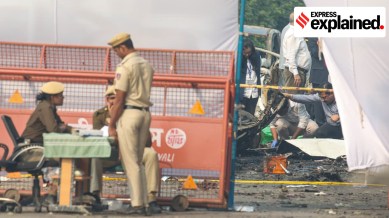Red Fort blast: What we know of probe so far, who ‘busted terror module’ was working for
Red Fort blast | Delhi Blast Probe Explained: Jammu and Kashmir police said the explosion appears to have been carried out by a 'transnational and interstate; module busted in Faridabad earlier. Here's what to know.

Delhi Red Fort Blast Explained: Death toll in the blast near Delhi’s Red Fort rose to 13 on Tuesday (November 11), with several more in hospitals with injuries. While the cause of the blast, which occurred in a Hyundai i20 car outside the Lal Quila Metro Station Gate number 1, is not clear yet, Prime Minister Narendra Modi called it a “conspiracy”, while Defence Minister Rajnath Singh said “those responsible for this tragedy will be brought to justice and will not be spared under any circumstances.”
“I wish to assure my fellow citizens that the country’s leading investigative agencies are conducting a swift and thorough inquiry into the incident. The findings of the investigation will soon be made public,” Singh said.
Here’s what we know about the blast and the probe so far.
Suspected links to Jaish-e-Mohammad, Ansar Ghazwatul Hind
The probe in the blast has been handed over to the National Investigation Agency (NIA).
Top police sources in Jammu and Kashmir have told The Indian Express that the explosion appears to have been carried out by a “transnational and interstate” module busted in Faridabad a day earlier.
In the days leading up to the blast, J&K Police had arrested two doctors from Haryana’s Faridabad and Uttar Pradesh’s Saharanpur for alleged links to the terror groups Jaish-e-Mohammad and Ansar Ghazwatul Hind (AGH).
The Jaish-e-Mohammed (JEM) is based in Pakistan. Founded by Masood Azhar after he was released from jail in India in the aftermath of the Indian Airlines Flight 814 hijacking, it aims to unite Kashmir with Pakistan. The Ansar Ghazwatul Hind, meanwhile, claimed to be an al-Qaeda affiliate in Kashmir, with the aim to establish an independent Islamic state of Kashmir.
What is the Faridabad case?
In the days before the Red Fort blast, two doctors from Kashmir were arrested in Haryana’s Faridabad and Uttar Pradesh’s Saharanpur for allegedly being part of a module working for Jaish and Ansar.
Dr Muzammil Ahmad Ganai from Pulwama was arrested first, leading to the arrest of Dr Adeel Majeed Rather from Qazigund. Ganai was employed at Al Falah Hospital in Faridabad, and the police had said they seized 358 kg of explosives suspected to be ammonium nitrate from Ganai’s rented home in Faridabad’s Dhauj village.
Police sources told The Indian Express they believe that Umar Nabi, a third doctor who went missing after Ganai’s arrest, is the likely bomber and the person captured on CCTV footage in the Hyundai i20. On Tuesday, police went to Nabi’s village in Pulwama to collect his mother’s DNA, to check if it matches with any of the unidentified bodies at the blast site.
The two doctors were arrested after the police started probing some posters supporting Jaish that had appeared on the outskirts of Srinagar city.
Police also said they seized around 3,000 kilograms of explosives, chemicals, reagents, inflammable material, electronic circuits and timers, as well as guns and ammunition, from the module. This included the 350 kg of explosive material recovered from the Faridabad doctor, Ganai.
The Red Fort blast site
In the news reports from the blast site, two things have been cited: that there was no crater and the victims did not have splinter wounds. While we don’t know yet what exactly happened, when a bomb goes off, the blast is generally intense enough to cause a crater on the ground, and the bomb casing splits and flies out, causing shrapnel and splinter wounds. More investigation is required to figure out what explosives were stored in the car and how they went off.
A blast is basically some substance undergoing rapid chemical reactions (due to heat or pressure) and releasing large amounts of gases and heat. In this case, investigators are checking the possible use of ammonium nitrate, fuel oil and detonators in the blast. Samples from the gutted vehicles, including the i20, have been collected for examination to confirm the exact composition and trigger mechanism. The use of RDX hasn’t been ruled out.